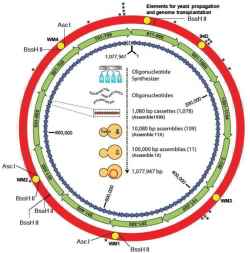Scientists have created bacteria-based artificial life [nearly]
![Scientists have created bacteria-based artificial life [nearly] Scientists have created bacteria-based artificial life [nearly]](https://static.digit.in/default/artImg75x64_4610.jpg)
We say nearly because they have created the ‘software’ part, which is no mean feat, considering it took nearly 15 years for them to do it. But is the hardware far behind?
Although we have evolved almost beyond recognition from our single-celled beginnings, the question of how life started has troubled scientists for a long time now. As typical scientific methodology prescribes, scientists are trying to find the answer to this big question by making efforts to generate life in the laboratory – life from lifeless chemicals. Genetic engineering is the manipulation of the genetic structure, DNA make-up, or genome of a living being, which is like the ‘source-code’ of the organism, present in every cell, determining everything about him/her/it. Although generating living cells from chemicals isn’t possible as of now, we have been tinkering with the chemicals that make up the DNA to create artificial genomes.
Now, a scientific team – headed by Drs. Craig Venter, Hamilton Smith and Clyde Hutchison of the J. Craig Venter Institute, USA – has created the first artificial bacterium by transplanting an artificially-created genome into a naturally occuring host cell. Or in a rough analogy, the operating system has been created, but is loaded in borrowed hardware. In 2008, the JCVI team synthesized a small bacterial genome; however they were unable to activate that genome in a cell at that time – the Beta version of the OS crashed. This time, however, the cell has ‘booted up’ and created over a billion copies of itself, which contained and displayed the characteristics of the synthetic DNA. This is the first cell controlled completely by a synthetic genome. The genome, known as Mycoplasma mycoides, is also a work of leviathanic proportions. It contains 1.08 million base pairs (like 1.08 million lines of code) and is the largest chemically defined structure ever synthesized in the laboratory. But to say at this point, that ‘Artificial life has been created’, would not be very accurate, as in this case, a synthetic genome was inserted into old microplasma cells, and that is not the same as ‘creating life’, for truly new life wouldn’t require an existing living recipient cell.
The new technique can allow us to create brand new genomes that do just what we demand of them. They could produce bio-fuels for us, gulp up the excess carbon-dioxide in the atmosphere or clear an oil-spill, like the one that has crippled the shores of Louisiana. But as Dr Helen Wallace from Genewatch UK – an organisation that monitors developments in genetic technologies – puts it, “If you release new organisms into the environment, you can do more harm than good. By releasing them into areas of pollution, [with the aim of cleaning it up], you could actually be releasing a new kind of pollution because we don’t know how these organisms will behave in the environment.”
Though we are now writing the software of life, we’d have to also look out for bugs and loopholes. If there’s a crash, the damage might not be reversible through a Quick Format.

